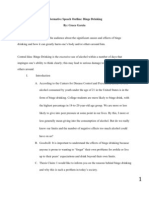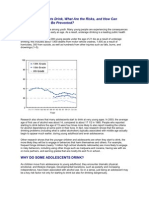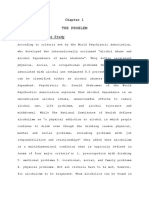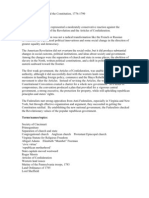Normal Drinking and Drug-Taking
Normal Drinking and Drug-Taking
Uploaded by
karunnalCopyright:
Available Formats
Normal Drinking and Drug-Taking
Normal Drinking and Drug-Taking
Uploaded by
karunnalOriginal Description:
Original Title
Copyright
Available Formats
Share this document
Did you find this document useful?
Is this content inappropriate?
Copyright:
Available Formats
Normal Drinking and Drug-Taking
Normal Drinking and Drug-Taking
Uploaded by
karunnalCopyright:
Available Formats
`BOOK REVIEW (2)
NORMAL DRINKING AND DRUG-TAKING Normal drug-taking and normal drinking are behaviors which remain
within certain legal, moral and cultural restraints, do not unduly interfere with the persons psychological or social integrity, and which do not cause him any physical harm. Normal can be used to mean normal, in a statistical sense, an ideal sense; a qualitative or quantitative, continuous or discontinuous variation from abnormal.
NORMAL DRINKING
In British households may actually underestimate the amount spent on drink, and the combined amount spent on alcohol and tobacco exceeds the amount spent on clothing. The Ansvar Insurance Company has carried out a survey of drinking habits on a nationally representative sample. They found that only 7 per cent of the population had never consumed alcohol. They found that beer was the commonest drink for men, particularly for frequent drinkers, while wine was the commonest drink of women and those who only drink occasionally. Drinking behaviors are known to vary with age, marital status and class differences. The number of frequent drinkers is higher in young, single men and decrease with social class. Frequency of drinking is important, but frequency patterns can conceal the total amount drunk. Developmental aspects of normal drinking Alcohol consumption is an important facet of life, and most children encounter it from a very early age. For the majority, drinking is begins in adolescence, but there is no doubt now that the majority of children experience
drinking personally in the early years of primary school. Important factors to drink the child (i) If a child perceives his father and other adult males to enjoy drinking, more likely he is to intend to drink. (ii) If he can recognize alcohol by smell, or has tasted it, the more likely he is to intend to drink. (iii) If he perceives his mother enjoying alcohol, the more likely he is to intend to drink. (iv) If he has experienced his fathers drunkenness the less likely he is to intend to drink Parental influences may be important because most boys and girls report that their parents were the first to introduce them to alcohol in the home situation. Young people as they grow older have more money to spend on alcohol. Drinking is a group activity, and drinkers give their main reason for drinking as the intention to be friendly and sociable. NORMAL DRUG-TAKING If youthful drinking mirrors parental drinking, then it is reasonable to postulate that illicit drug-taking in adolescents reflects the drug-taking habits of parents. It will also affect so many health problems. The broader issue of the effect of drug-taking on society concerns the widely-discussed aspect of the stress of modern living and our increasing intolerance of suffering from such stress. Models and Theories (i) Genetic predisposition model: - Inclination to that substance is
genetically in birth.
(ii)
Behavioural learning: - Behavior is the care issue. It also affected social
environment. It develops over a period of time. (iii) Cognitive model: - Development of thought process. Whenever that is
failure they started alcohol. (iv) (v) Psycho-analytic model: - In this oral gratification is important. Parental influence mode: - In this parents are very important. The parents
are drink the children are likely to drink. (vi) Psycho-social model:- Which manipulate social and psychological
factors in the environment.
You might also like
- Small Unit Infantry Ambush Tactics Ambush Techniques and Battlecraft For Infantry Squads and Platoons by Special TacticsDocument126 pagesSmall Unit Infantry Ambush Tactics Ambush Techniques and Battlecraft For Infantry Squads and Platoons by Special TacticsGaf Recruiting71% (7)
- Conjoint Family Therapy - Book ReviewiewDocument4 pagesConjoint Family Therapy - Book Reviewiewkarunnal100% (2)
- Chapter 1-5Document43 pagesChapter 1-5Corinne Artatez100% (10)
- Research On Practical Research 1Document54 pagesResearch On Practical Research 1ZOSIMO PIZONNo ratings yet
- Informative Speech OutlineDocument5 pagesInformative Speech OutlineGrace R Garcia50% (2)
- To Get Rich Is GloriousDocument30 pagesTo Get Rich Is GloriousMariz EreseNo ratings yet
- INTRODUCTIONDocument46 pagesINTRODUCTIONSATHISHKUMAR SNo ratings yet
- Mr. Ian OSullivan and Ms. Eimear Murphy, Colaiste Treasa, Kanturk, Co. CorkDocument3 pagesMr. Ian OSullivan and Ms. Eimear Murphy, Colaiste Treasa, Kanturk, Co. CorkIfa YukiiNo ratings yet
- Topic Proposal Defense SampleDocument2 pagesTopic Proposal Defense SampleRiza RuizNo ratings yet
- 13 Real Kids Are Curious About Alcohol A Family Guide To Underage Drinking PreventionDocument51 pages13 Real Kids Are Curious About Alcohol A Family Guide To Underage Drinking Preventionapi-309082881No ratings yet
- Thesis On Teenage AlcoholismDocument4 pagesThesis On Teenage AlcoholismRick Vogel100% (2)
- Teen Drinking Troubles and AnswersDocument7 pagesTeen Drinking Troubles and AnswersAyalaWalsh2No ratings yet
- SAA - TeensDocument10 pagesSAA - TeensLetlhogonolo Molokomme MokhuseNo ratings yet
- AlcoholismDocument19 pagesAlcoholismKweng Kweng DoongNo ratings yet
- Effects of Alcohol Drinking in The Physical and Mental Health of The Selected Students of Grade-12 of Polillo National High School-Senior HighDocument15 pagesEffects of Alcohol Drinking in The Physical and Mental Health of The Selected Students of Grade-12 of Polillo National High School-Senior HighElaine Key MarasiganNo ratings yet
- Research Paper Jiechel Group June 21, 2021Document38 pagesResearch Paper Jiechel Group June 21, 2021dolly kate cagadas100% (1)
- Chapter 2Document7 pagesChapter 2rolando mancoNo ratings yet
- Alcohol Abuse Thesis StatementDocument5 pagesAlcohol Abuse Thesis Statementsandyharwellevansville100% (2)
- Format Conclusion and Recommendation Humss & HeDocument28 pagesFormat Conclusion and Recommendation Humss & HeAriana FiestaNo ratings yet
- Alcoholism: Alcoholism Is The Most Serious Form of ProblemDocument12 pagesAlcoholism: Alcoholism Is The Most Serious Form of ProblemfrajvalNo ratings yet
- Chapter 1Document21 pagesChapter 1Sandeep K RNo ratings yet
- Effects of Drinking LiquorDocument15 pagesEffects of Drinking LiquorTrond IturriosNo ratings yet
- A Position Paper On The Legalization of Alcoholic Drinks To MinorsDocument2 pagesA Position Paper On The Legalization of Alcoholic Drinks To MinorsCristine Joy Remerata Villarosa69% (13)
- Why Do Adolescents DrinkDocument6 pagesWhy Do Adolescents DrinkchukisaliNo ratings yet
- Title: The Effect of Drinking Alcohol To The StudentsDocument2 pagesTitle: The Effect of Drinking Alcohol To The StudentsEjay IgnacioNo ratings yet
- Background and Its InformationDocument9 pagesBackground and Its InformationJm Jeffrey MarceloNo ratings yet
- Llenas Group Pr2Document80 pagesLlenas Group Pr2Jasmine GumandoyNo ratings yet
- Lesson 6 Risky Behavior of TeenagersDocument7 pagesLesson 6 Risky Behavior of TeenagersCatherine LeeNo ratings yet
- Influence_factors_of_adolescent_drinking_behaviorDocument7 pagesInfluence_factors_of_adolescent_drinking_behaviorMạc LinhNo ratings yet
- Thesis BodyDocument13 pagesThesis Bodyreginexanthe100% (1)
- teen and drugs abuseDocument27 pagesteen and drugs abuseswarajghanekar03No ratings yet
- (PT) RRL Research Week 5 & 6Document14 pages(PT) RRL Research Week 5 & 6Ariana FiestaNo ratings yet
- Gender and Society 7Document7 pagesGender and Society 7Jason Roel LlenaNo ratings yet
- The Effect of Alcoholism Toward AcademicDocument27 pagesThe Effect of Alcoholism Toward AcademicJayson Fabrigas VillafrancaNo ratings yet
- Introduction Topic Is Because Lots and Lots of People Tend To Drink A Lot. I Wonder Why They Love To DrinkDocument4 pagesIntroduction Topic Is Because Lots and Lots of People Tend To Drink A Lot. I Wonder Why They Love To DrinkElla CarilloNo ratings yet
- Psycholog Y Case Study: Efforts byDocument35 pagesPsycholog Y Case Study: Efforts bysheenNo ratings yet
- Alcohol ThesisDocument4 pagesAlcohol Thesispatriciamedinadowney100% (1)
- Dr. Ram Manohar Lohiya National Law University: Sociology Final Draft On: Youth Addiction To AlcoholDocument8 pagesDr. Ram Manohar Lohiya National Law University: Sociology Final Draft On: Youth Addiction To AlcoholNevedita SinghNo ratings yet
- IMRaD - Week 3 & 4Document8 pagesIMRaD - Week 3 & 4Ariana FiestaNo ratings yet
- Alcoholism Essay ThesisDocument8 pagesAlcoholism Essay Thesisdebrapereaalbuquerque100% (2)
- RESEARCHDocument12 pagesRESEARCHCHAPLAIN JEAN ESLAVA100% (1)
- Risky Behaviors of AdolescentsDocument8 pagesRisky Behaviors of AdolescentsMary CaputeroNo ratings yet
- LESSON 4-Risky Behaviors of AdolecentsDocument8 pagesLESSON 4-Risky Behaviors of AdolecentsMary CaputeroNo ratings yet
- Essay On Alcohol Abuse Among Teenagers PDFDocument4 pagesEssay On Alcohol Abuse Among Teenagers PDFDamien Ashwood100% (1)
- Research Alcoholism 1Document6 pagesResearch Alcoholism 1Bless CotingjoNo ratings yet
- Foreign StudiesDocument2 pagesForeign StudiesLovelle MendozaNo ratings yet
- Pre-Thesis (On Alcohol)Document6 pagesPre-Thesis (On Alcohol)Vlad Lipsam0% (1)
- RISKY BEHAVIORS OF ADOLESCENTS ModuleDocument5 pagesRISKY BEHAVIORS OF ADOLESCENTS Module23-0246-tleNo ratings yet
- IntroductionDocument3 pagesIntroductioneibred03142008No ratings yet
- Thesis On Alcoholism PDFDocument5 pagesThesis On Alcoholism PDFkatyanalondonomiramar100% (2)
- MR Binge Drinking ReportDocument34 pagesMR Binge Drinking ReportAaron BernardNo ratings yet
- Under Age Drinking: By: ShadrackDocument8 pagesUnder Age Drinking: By: ShadrackasalaamalaikumNo ratings yet
- Alcohol Essay ThesisDocument6 pagesAlcohol Essay Thesisslqjdoikd100% (2)
- 12 Parenting To Prevent Childhood Alcohol UseDocument5 pages12 Parenting To Prevent Childhood Alcohol Useapi-309082881No ratings yet
- Medical Association, 92 Percent of Victims of Domestic Violence Reported That The Assailant HadDocument4 pagesMedical Association, 92 Percent of Victims of Domestic Violence Reported That The Assailant HadlxozzNo ratings yet
- Vsaac Community Report 2010 - WebDocument5 pagesVsaac Community Report 2010 - WebBHcareNo ratings yet
- Psychology Case Study 3Document19 pagesPsychology Case Study 3kayash706No ratings yet
- Practical ResearchDocument28 pagesPractical ResearchMary Joy Lascuña100% (1)
- Alcohol Abuse: Societal Issue ProblemDocument13 pagesAlcohol Abuse: Societal Issue ProblemJulius MacaballugNo ratings yet
- 1006 - Counselling Department 10Document9 pages1006 - Counselling Department 10Letlhogonolo Molokomme MokhuseNo ratings yet
- Alcohol, Youth & Its Impact On HealthDocument27 pagesAlcohol, Youth & Its Impact On HealthnashprinceNo ratings yet
- Thesis Na TotooDocument48 pagesThesis Na TotooJade MauriceeNo ratings yet
- The Family and Hiv TodayDocument6 pagesThe Family and Hiv TodaykarunnalNo ratings yet
- Problem ChildrenDocument4 pagesProblem ChildrenkarunnalNo ratings yet
- Ethical Issues - PeaceDocument2 pagesEthical Issues - PeacekarunnalNo ratings yet
- # Ombudsman v. ValeraDocument3 pages# Ombudsman v. ValeraRuby ReyesNo ratings yet
- Genesis V UNYONDocument6 pagesGenesis V UNYONMorphuesNo ratings yet
- APUSH Study Guide 8-12Document11 pagesAPUSH Study Guide 8-12septemberleaves95No ratings yet
- English 9 Quarter 3 Module 2 Bias and PrejudicesDocument29 pagesEnglish 9 Quarter 3 Module 2 Bias and Prejudicesmorenojennyrose9No ratings yet
- CBCP Monitor Vol. 18 No. 4Document20 pagesCBCP Monitor Vol. 18 No. 4Areopagus Communications, Inc.No ratings yet
- Er DiagramDocument1 pageEr DiagramPrachi YadavNo ratings yet
- Worksheet 3 - Fighting Child Labour in The USA and The UK PDFDocument2 pagesWorksheet 3 - Fighting Child Labour in The USA and The UK PDFdidaNo ratings yet
- Locsin V CADocument6 pagesLocsin V CAKenmar NoganNo ratings yet
- High Court of Australia: Gleeson CJ, Gummow, Kirby, Hayne, Callinan, Heydon and Crennan JJDocument239 pagesHigh Court of Australia: Gleeson CJ, Gummow, Kirby, Hayne, Callinan, Heydon and Crennan JJBBB22No ratings yet
- CASE No. 37 Commissioner of Internal Revenue vs. AICHI FORGING COMPANY OF ASIA INCDocument1 pageCASE No. 37 Commissioner of Internal Revenue vs. AICHI FORGING COMPANY OF ASIA INCJonel L. SembranaNo ratings yet
- CCA All Scenarios Statistics v1Document12 pagesCCA All Scenarios Statistics v1David San-BrionesNo ratings yet
- Lecture outline-WPS OfficeDocument11 pagesLecture outline-WPS Officepaco kazunguNo ratings yet
- Non Violent AtonementDocument9 pagesNon Violent AtonementdivromNo ratings yet
- Marenostrum PDFDocument104 pagesMarenostrum PDFFox1A1100% (1)
- Annual Report of Immigrant Visa Applicants in The Family-Sponsored and Employment-Based Preferences Registered at The National Visa Center As of November 1, 2021Document15 pagesAnnual Report of Immigrant Visa Applicants in The Family-Sponsored and Employment-Based Preferences Registered at The National Visa Center As of November 1, 2021RFCapRNNo ratings yet
- Admin Law Q and ADocument11 pagesAdmin Law Q and AkhristianjeffepiscopeNo ratings yet
- The Man Eater: PorisadaDocument14 pagesThe Man Eater: PorisadaMindStilled100% (1)
- Reaksyon Sa Napapanahong Isyu NG BansaDocument1 pageReaksyon Sa Napapanahong Isyu NG BansaMaxinne Catrisha David100% (2)
- Rubiso vs. Rivera, 37 Phil. 72Document2 pagesRubiso vs. Rivera, 37 Phil. 72Reny Marionelle BayaniNo ratings yet
- San Simon, PampangaDocument2 pagesSan Simon, PampangaSunStar Philippine NewsNo ratings yet
- 10 Creative Thinking PuzzlesDocument32 pages10 Creative Thinking PuzzlesLipika DasNo ratings yet
- CHECKLIST OF REQUIREMENTS 2 1 Updated PDFDocument7 pagesCHECKLIST OF REQUIREMENTS 2 1 Updated PDFVivian J. PasolotNo ratings yet
- GV Florida Vs Heirs of BattungDocument14 pagesGV Florida Vs Heirs of BattungLORELEI LOUISE A„ORA DELOSONo ratings yet
- History of Income Tax in PakistanDocument37 pagesHistory of Income Tax in PakistanSoNaa BalochNo ratings yet
- Regulatory Framework For Business Transactions: ST NDDocument9 pagesRegulatory Framework For Business Transactions: ST NDMark Domingo MendozaNo ratings yet
- Hit Them Up - Tradução - Pesquisa GoogleDocument6 pagesHit Them Up - Tradução - Pesquisa GoogleDaniel SousaNo ratings yet
- Calling DataDocument8 pagesCalling Datatradewithrajeev1786No ratings yet
- Goh Teng WhooDocument21 pagesGoh Teng WhooDanica DivyaNo ratings yet





























































































